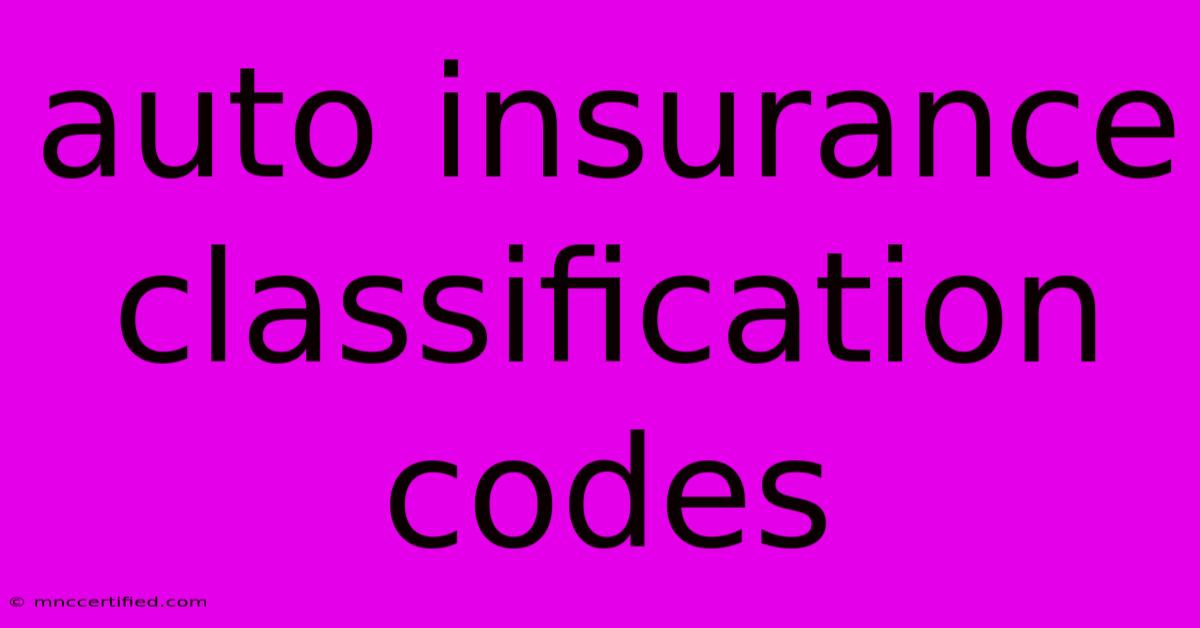Auto Insurance Classification Codes

Table of Contents
Unveiling the Mystery: Demystifying Auto Insurance Classification Codes
Ever wondered why your car insurance premium seems a little higher or lower than your friend's? It's not just about luck, it's about auto insurance classification codes. These seemingly cryptic codes, assigned to each vehicle, play a significant role in determining your insurance rates.
Understanding the Basics
Auto insurance classification codes are essentially a standardized system used by insurance companies to categorize vehicles based on various factors that influence risk. Think of them as a shorthand for specific characteristics that impact the likelihood of an accident or the cost of repairs.
Why are Classification Codes Important?
These codes act as the foundation for calculating your insurance premiums. Here's how they work:
- Risk Assessment: Insurance companies analyze historical data and accident statistics for different vehicle types, making it possible to estimate the potential risk associated with each.
- Premium Determination: Based on the risk assessment, they assign classification codes that correspond to specific premium rates. Higher risk vehicles often carry higher premiums, reflecting the increased likelihood of claims.
- Fairness and Transparency: The system aims to ensure fairness by assigning rates based on objective factors rather than subjective biases.
Key Factors Influencing Classification Codes
Several factors contribute to a vehicle's classification code, influencing its premium:
1. Vehicle Make and Model:
- Safety Features: Cars equipped with advanced safety features like anti-lock brakes, airbags, and stability control often receive lower codes due to their improved safety performance.
- Repair Costs: Vehicles with expensive parts or complex repairs may have higher codes, reflecting the higher potential cost of claims.
- Theft Risk: Cars with a history of theft are likely to have higher codes, considering the potential for theft-related claims.
2. Vehicle Usage:
- Commuting Distance: Regular long-distance commutes increase exposure to traffic, potentially leading to a higher code.
- Business Use: Cars used for commercial purposes typically have higher codes due to their increased exposure to accidents.
3. Driver Profile:
- Age and Driving Experience: Younger and less experienced drivers generally have higher codes as they have a higher risk of accidents.
- Driving Record: Accidents, tickets, and driving violations will undoubtedly result in higher codes.
Decoding the Codes
While the specific codes used may vary between insurance companies, the underlying principles remain consistent. Here's a simplified example:
- Code 10: This could represent a standard, well-maintained sedan with a good safety rating.
- Code 15: This could indicate a sporty car with a higher performance rating, potentially carrying a higher risk of accidents.
- Code 20: This could denote a commercial vehicle used for business purposes, with a higher potential for accidents due to heavy use.
Understanding your Classification Code
Reviewing your policy documents can help you identify your vehicle's classification code. Don't hesitate to ask your insurance agent for clarification if you're unsure. Understanding your code can empower you to make informed decisions:
- Negotiating Rates: If you believe your vehicle is misclassified, discuss it with your agent. They may be able to adjust the code based on your specific circumstances.
- Improving your Driving Record: Maintaining a clean driving record is crucial for lowering your code and potentially your premiums.
- Exploring Discounts: Ask about potential discounts for safety features, good driving history, or vehicle modifications that could lower your code.
Conclusion
Auto insurance classification codes are an important factor in determining your premiums. Understanding the factors influencing your vehicle's code can help you navigate the insurance landscape, potentially reducing your costs and ensuring you're paying a fair price for your coverage.

Thank you for visiting our website wich cover about Auto Insurance Classification Codes. We hope the information provided has been useful to you. Feel free to contact us if you have any questions or need further assistance. See you next time and dont miss to bookmark.
Featured Posts
-
Farmer Insurance Claim Phone Number
Nov 13, 2024
-
Angulo Fc Cincinnati Midfielder Dies In Car Accident
Nov 13, 2024
-
Brits Urged To Switch Off Six Appliances
Nov 13, 2024
-
Leadbeater Mps Views On Assisted Dying Bill
Nov 13, 2024
-
Bluesky Sees User Boom Post Trump Win
Nov 13, 2024